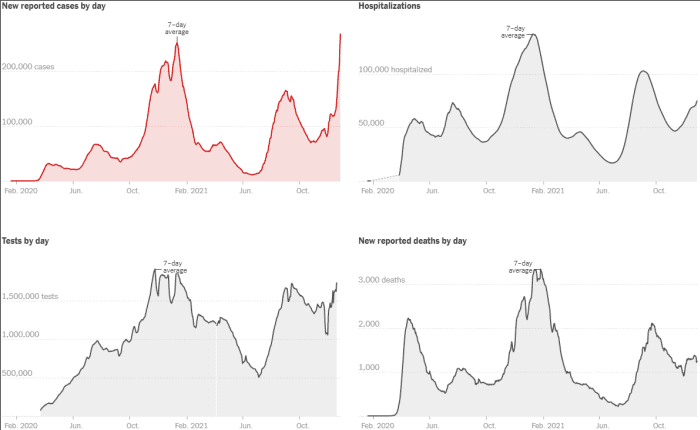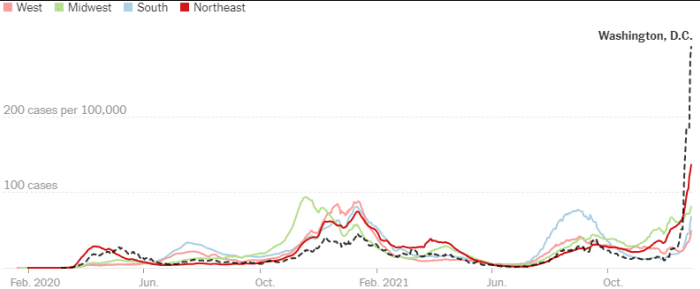This post was originally published on this site
As the daily average of new cases of the coronavirus that causes COVID-19 leapt to a new post-pandemic high, the director of the Centers for Disease Control and Prevention expressed some cautious optimism that while new cases may continue to climb, the worst in terms of disease severity may be over.
The seven-day average of new cases rose to 267,305 on Tuesday from 243,099 on Monday, and has now well-more than doubled — up 126% — in two weeks, according to a New York Times tracker. That surpassed the previous peak of 251,232 reached on Jan. 11, 2021.
Read MarketWatch’s daily “Coronavirus Update” column.
Early studies have shown that the omicron variant is far more infectious than other variants, but may cause less severe illness.
Helping support those studies, the NYT data showed that the daily average of hospitalizations in the U.S. increased 11% from two weeks ago to 74,962, which was the most since Oct. 2, but was just a little over half the pandemic peak of 137, 516 seen on Jan. 10.
And the daily average of deaths fell 3% to 1,243. While that was still a high number, it was well below the Jan. 26 peak of 3,342.
Meanwhile, the daily average of tests rose 18% to 1.73 million, still below the pandemic peak over just over 1.9 million seen in November.

The New York Times
Speaking on MSNBC’s “Morning Joe” show Wednesday morning, CDC Director Dr. Rochelle Walensky said she has started to see data from other countries that for every 100 people infected with the omicron variant, there is “less severe” disease than you might have with other variants, especially for people who have been vaccinated. She qualified that, however, by saying “we may still have many many more cases,” so there may still be a lot of severe disease in hospitals to come.
“I want to project optimism, and I want to be cautious in doing so,” Walensky said.
She also tried to clarify the CDC’s reasoning behind halving its recommended time for infected people to isolate to five days, saying it was a matter of “practical guidance” that people can follow.
Walensky said data shows that 85% to 90% of all transmission of the coronavirus happens in the 1-to-4 days before, and the 2-to-3 days after, symptoms appear. She said the CDC is recommending people wear masks for five days after that isolation period, to try to fend off any “residual transmission.”
Surprisingly, Walensky also downplayed the usefulness of getting tested during and after the isolation period. She said PCR tests can stay positive for 12 weeks after infection. And in terms of the antigen rapid tests, “we actually don’t know how those tests perform,” whether they can actually predict if the virus can be transmitted.
So for those taking an antigen test after the 5-day period of isolation: “If you are negative, we would say still wear your mask. And if you are positive, we would say, still wear your mask,” she said.
Basically, getting tested wouldn’t change the recommended isolation period, or the recommendation to wear a mask in the five days that followed. She did, however, recommend people get antigen tests after they’ve been exposed.
More numbers
Areas in the U.S. showing the greatest increases in average daily cases per capita were Washington, D.C., by far, and the Northeast region, according to NYT data, followed by the Midwest, South and West regions.

Cases by region
The New York Times
States with the highest daily average of new cases per 100,000 people as of Tuesday were New York with 293, New Jersey with 173 and Rhode Island with 138, while states with the most hospitalizations per 100,000 were Ohio with 44, Indiana with 43 and Delaware with 43.
In terms of vaccinations, the latest data from the CDC showed that the number of fully vaccinated Americans who are at least five years old, which is the age in which people are eligible to be vaccinated, edged up to 205,410,786, or 65.8% of that population. Meanwhile the number of people at least 18 years old who are fully vaccinated is 187,872,908, or 72.7% of the adult population.
That suggests that 17,537,878 people at least 5 years old to up to 17 years old, or roughly one-third of that population, have been fully vaccinated.
Meanwhile, 66.9 million adult Americans have received booster shots, or 35.6% of that population.
Global tallies
The global tally for the coronavirus-borne illness rose to 283.13 million as of midday Wednesday, while the death toll grew to 5.42 million, according to data aggregated by Johns Hopkins University.
The U.S. remains the world leader in total cases, with more than 53.22 million, and in deaths, at 821,346.
India is second by cases after the U.S. at 34.81 million and has suffered 480,592 deaths, as of the latest count. Brazil has the world’s second highest death toll at 618,978 and is third in cases at 22.26 million.
In Europe, Russia has had the most fatalities at 300,886, while the U.K. has had the most cases with 12.41 million.

